Louisiana’s wetlands, forests, and bayous provide an ideal environment for countless insects and spiders, many of which play vital ecological roles. However, some of these creatures are capable of delivering painful stings, venomous bites, or spreading harmful diseases. Knowing which bugs pose a risk is essential for staying safe outdoors.
The state’s warm, humid climate allows dangerous species like fire ants, mosquitoes, and brown recluse spiders to thrive almost year-round. These pests often become more active during spring and summer, hiding in shaded areas, under rocks, or near homes. Their presence is not always obvious until an unfortunate encounter occurs.
This guide highlights 23 of the most dangerous bugs in Louisiana, explaining their identifying traits, habitats, and potential dangers. Understanding these insects not only helps prevent bites and stings but also promotes safer outdoor exploration and greater respect for Louisiana’s diverse ecosystem.
Types of Dangerous Bugs Found in Louisiana
Asian Giant Hornet (Vespa mandarinia)

The Asian Giant Hornet, sometimes sensationally called the “murder hornet,” is the largest hornet species in the world, measuring up to 2 inches (50 mm) in length with an enormous 3-inch (75 mm) wingspan. It has an orange-yellow head, large mandibles, dark brown eyes, and a black-and-orange striped abdomen. Its size and buzzing flight make it an intimidating sight.
Native to Asia, this hornet has been detected occasionally in parts of the Pacific Northwest, raising concern over its potential invasiveness. It builds underground nests and preys on honeybees, using its strong mandibles to decapitate them before feeding the remains to larvae. A small group of Asian Giant Hornets can destroy an entire honeybee colony within hours, posing a serious threat to local pollinator populations and agriculture.
The sting of this hornet is extremely painful and can deliver a large amount of venom containing neurotoxins and cytotoxins. Multiple stings can lead to kidney damage, tissue necrosis, or even death in rare cases, especially if the victim is allergic. While they rarely target humans unless threatened, their size and strength make encounters dangerous. Prompt medical attention is recommended after any sting, and experts advise reporting sightings to local wildlife authorities to prevent their spread.
Brown Recluse Spider (Loxosceles reclusa)
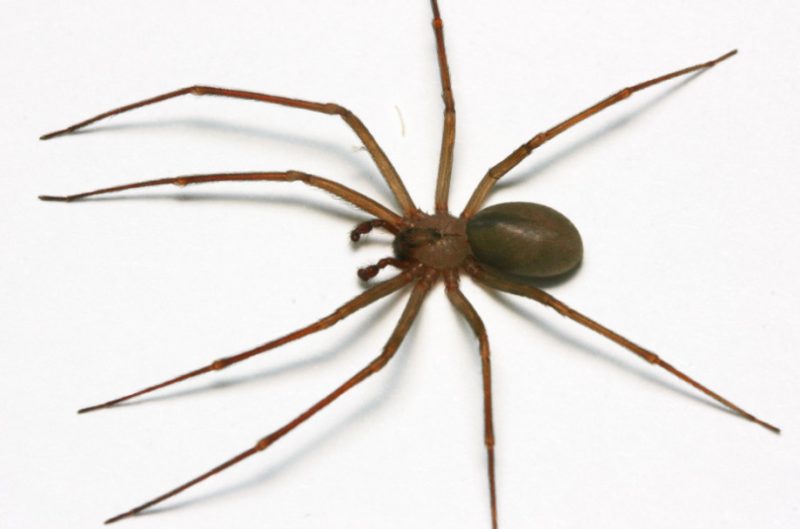
The Brown Recluse Spider is one of the most feared arachnids in the United States due to its venomous bite. It is typically light to medium brown in color with a distinctive dark, violin-shaped marking on its back, which helps in identification. Adults measure about 6 to 20 millimeters in body length, with long, delicate legs that make it appear larger. This spider has six eyes arranged in pairs, unlike most spiders that have eight eyes.
Brown Recluse Spiders prefer dark, dry, and undisturbed places such as basements, attics, closets, and sheds. They are mostly nocturnal and feed on small insects and other spiders, ambushing their prey rather than building webs to trap it. During the day, they hide in sheltered areas, often behind furniture or inside clothing and shoes that have been left unused for some time.
The bite of a Brown Recluse can cause severe necrotic skin lesions, as its venom contains enzymes that destroy tissues. While not all bites are dangerous, severe cases can lead to ulceration and secondary infections requiring medical attention. The initial bite may go unnoticed, but within hours, pain, redness, and blistering may appear. People living in the southern and central United States should exercise caution when handling stored items in spider-prone areas.
Black Widow Spider (Latrodectus mactans)
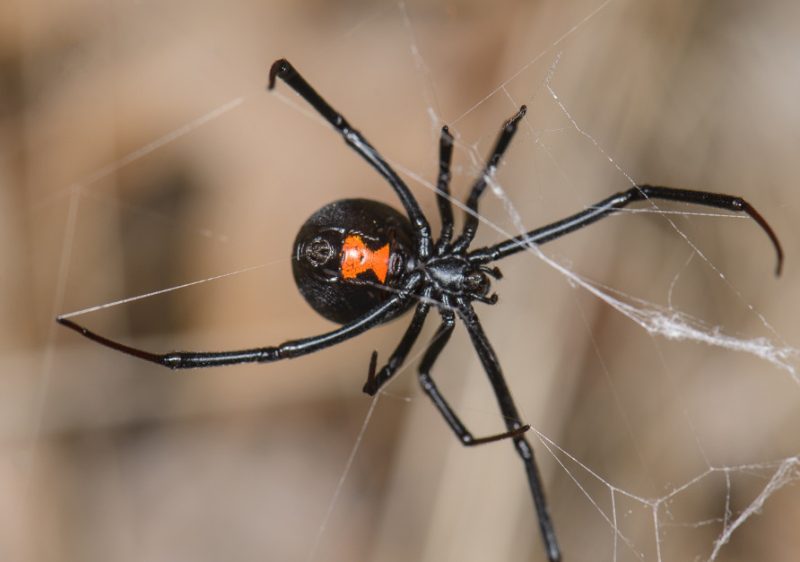
The Black Widow Spider is easily recognizable by its shiny black body and the bright red hourglass marking on the underside of its abdomen. Females are much larger than males, measuring about 1.5 inches (38 mm) including leg span, while males are smaller and less venomous. Their sleek, round abdomen and long, spindly legs give them a distinct and somewhat intimidating appearance.
These spiders build irregular, messy webs in dark, sheltered areas such as woodpiles, sheds, garages, and under outdoor furniture. They are not aggressive and typically bite only when disturbed or threatened. Black Widows primarily feed on insects such as flies, mosquitoes, and beetles, using their sticky silk to capture prey before injecting venom to immobilize it.
The venom of the Black Widow contains a neurotoxin that affects the nervous system, leading to symptoms such as severe pain, muscle cramps, nausea, and sweating. Though rarely fatal to healthy adults, bites can be very painful and dangerous for children, the elderly, or individuals with weakened immune systems. Immediate medical attention is recommended if bitten. Preventing encounters involves wearing gloves when handling firewood or debris and keeping storage areas clean and clutter-free.
Red Imported Fire Ant (Solenopsis invicta)
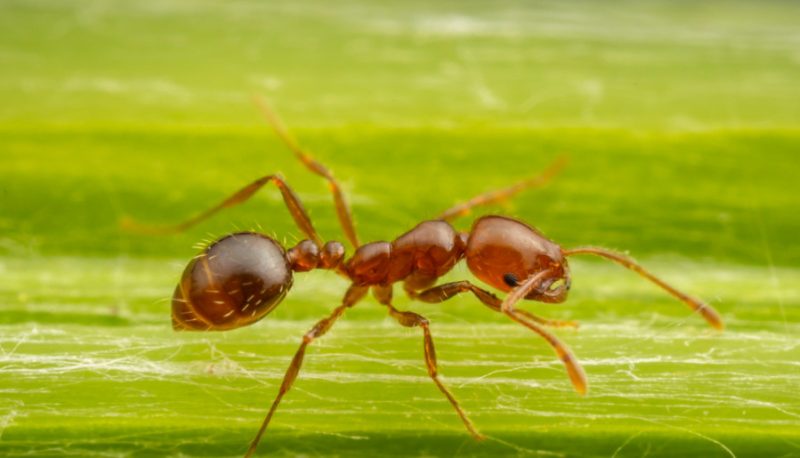
The Red Imported Fire Ant is a small but aggressive insect known for its painful sting and territorial behavior. These ants are reddish-brown with darker abdomens and measure about 1/8 to 1/4 inch in length. They are equipped with strong mandibles for biting and a venomous stinger at the end of the abdomen used to inject toxins into their victims.
Fire ants build large, dome-shaped mounds in open, sunny areas such as lawns, fields, and pastures. They are highly social insects that live in colonies containing thousands of workers and one or more queens. When disturbed, the colony responds aggressively, swarming over intruders and delivering multiple stings in quick succession. Their diet includes insects, seeds, plants, and even small animals, making them an invasive pest in many regions.
Their sting produces a burning sensation followed by itchy, pus-filled blisters that can last for several days. In some individuals, multiple stings can trigger allergic reactions or anaphylaxis, which is potentially life-threatening. Fire ants are native to South America but have spread widely across the southern United States, posing risks to both humans and wildlife. Careful mound management and professional pest control are often needed to control infestations.
Eastern Carpenter Bee (Xylocopa virginica)
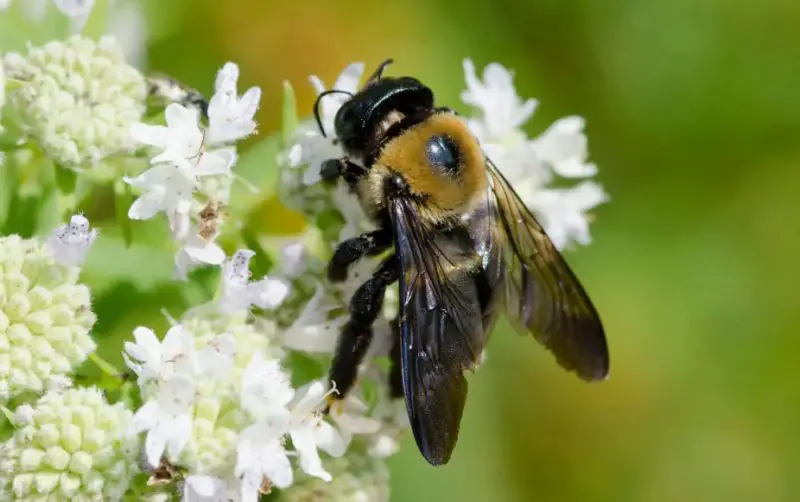
The Eastern Carpenter Bee is a large, robust species that resembles a bumblebee but can be distinguished by its shiny, hairless black abdomen. Adult females measure about 1 inch (25 mm) long, while males are slightly smaller and have a pale patch on their faces. Despite their intimidating size and buzzing flight, these bees are mostly non-aggressive and rarely sting unless directly handled.
Carpenter bees are solitary insects that bore into untreated or unpainted wood to create nesting tunnels, often in eaves, decks, and wooden fences. Females excavate circular holes where they lay eggs and seal them with chewed wood pulp. Males are territorial and may hover near humans, but they lack stingers and are harmless. The species plays an important ecological role as a pollinator for a wide variety of flowering plants.
Although carpenter bees do not pose a direct danger to humans, their nesting activity can cause structural damage to wooden surfaces over time. Repeated infestations can weaken beams or decks. To deter them, wood surfaces should be painted or sealed, and entry holes can be treated or plugged once bees have left. Their sting is mild compared to that of wasps or hornets, but allergic individuals should still exercise caution.
Paper Wasp (Polistes spp.)
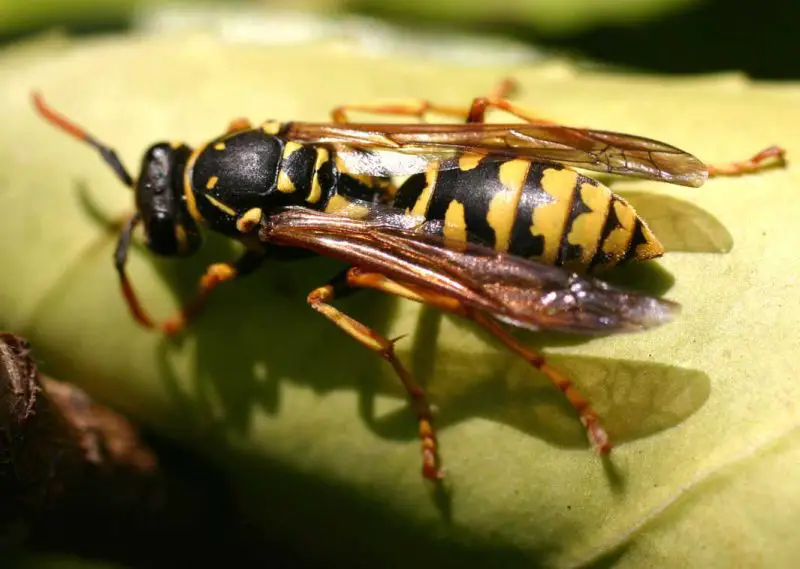
Paper Wasps are slender-bodied insects with narrow waists, long legs, and distinctive brown or reddish coloration with yellow markings. Adults measure about 0.75 to 1 inch in length and are often mistaken for hornets. They are named for their nests, which are made of chewed plant fibers mixed with saliva, forming paper-like hexagonal cells that hang from a single stalk.
These wasps are commonly found around human dwellings, especially under eaves, porch ceilings, or branches. Paper Wasps are beneficial predators that feed on caterpillars, flies, and other soft-bodied insects, helping to control garden pests. They are social insects living in small colonies, with a single queen and several workers maintaining the nest and larvae.
While generally non-aggressive, Paper Wasps will defend their nest vigorously if threatened. Their sting is painful and can cause redness, swelling, and itching. In sensitive individuals, multiple stings can trigger allergic reactions or even anaphylaxis. Unlike honeybees, Paper Wasps can sting multiple times. To prevent stings, it’s best to observe them from a distance and avoid disturbing active nests, especially during the warmer months when colonies are most active.
Yellowjacket Wasp (Vespula spp.)
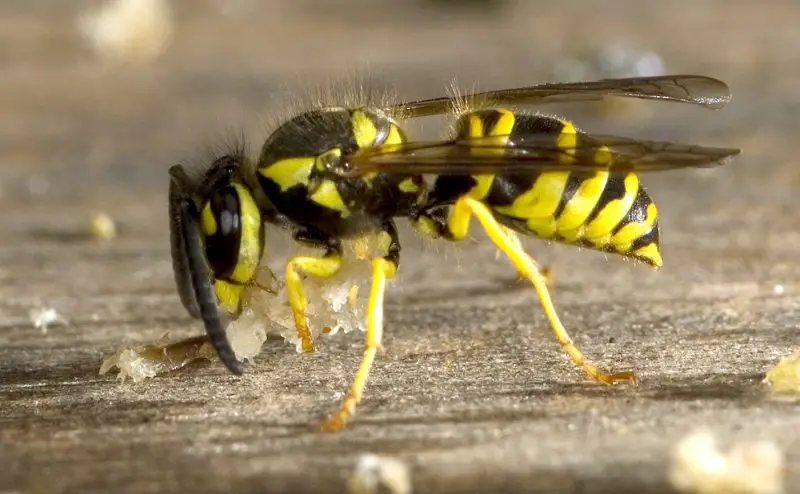
Yellowjackets are aggressive wasps known for their bold black and yellow coloration and rapid, darting flight patterns. Measuring about 0.5 inches (12–16 mm) long, these wasps have smooth, shiny bodies and a narrow waist typical of vespid species. Unlike honeybees, yellowjackets have no hair for pollen collection and are built for scavenging and hunting. Their powerful mandibles allow them to tear flesh and food, while their stingers can inject venom multiple times.
These wasps build paper-like nests made of chewed wood fibers, often hidden underground, in wall cavities, or under eaves. Colonies can contain thousands of individuals during peak summer months. Yellowjackets are opportunistic feeders, consuming sugary foods, meats, and carrion. They play an ecological role in controlling pest insects but are notorious for raiding picnics and trash bins, especially late in the season when natural food sources decline.
Their sting is extremely painful and can cause redness, swelling, and itching. Multiple stings may trigger systemic allergic reactions or anaphylaxis, requiring immediate medical attention. Because yellowjackets defend their nests aggressively, mowing near hidden ground nests or disturbing colonies can provoke swarming attacks. To minimize encounters, seal garbage containers, cover food outdoors, and contact pest control professionals if a nest is located near living areas.
Bald-faced Hornet (Dolichovespula maculata)
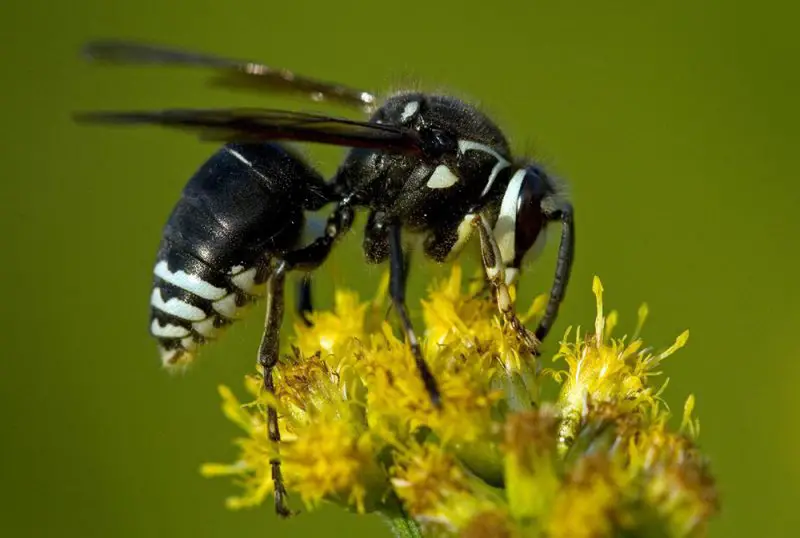
The Bald-faced Hornet is actually a large species of yellowjacket rather than a true hornet, easily recognized by its black body with white markings on the face and thorax. Adults typically measure 0.75 to 1 inch (19–25 mm) long and have a distinctive ivory-white pattern that contrasts sharply with their dark coloration. These hornets are strong fliers and often seen hovering near trees or structures where they build their nests.
They construct large, football-shaped paper nests high in trees, shrubs, or on buildings. Made from chewed wood fibers, these nests can reach the size of a basketball and contain hundreds of workers by mid-summer. Bald-faced Hornets are beneficial predators, feeding on flies, caterpillars, and other insects. Despite their positive ecological role, they become defensive when their nest is disturbed and will sting repeatedly to protect the colony.
Their sting delivers a potent venom that causes immediate, intense pain followed by swelling and redness. Unlike honeybees, Bald-faced Hornets retain their stinger and can attack multiple times. While not typically aggressive when foraging, they will chase perceived threats over long distances once provoked. Their venom can cause serious allergic reactions in sensitive individuals. It’s advisable to avoid approaching their nests and to seek professional removal if they’re located near human activity areas.
Mosquito (Aedes aegypti, Aedes albopictus)
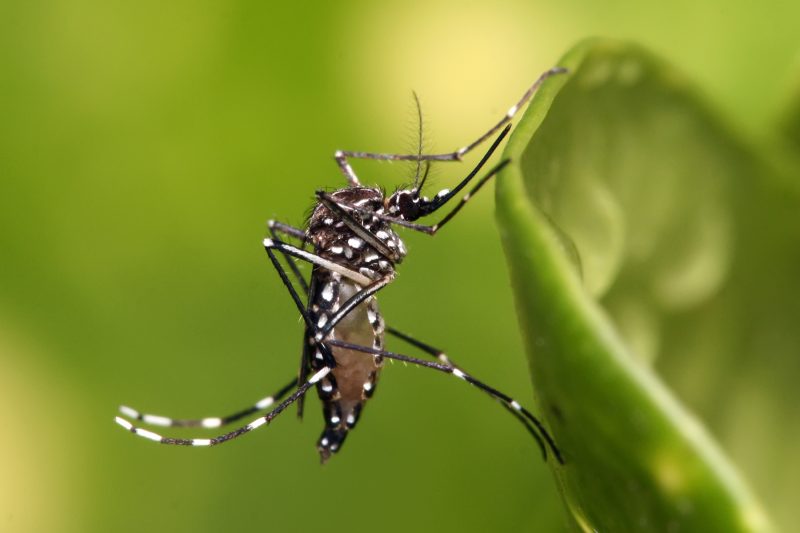
Mosquitoes are small, slender insects measuring about 0.15 inches (3–4 mm) with long legs and a distinctive proboscis used for feeding on blood. The Aedes aegypti, known as the Yellow Fever Mosquito, has white markings on its legs and a lyre-shaped pattern on its thorax, while Aedes albopictus, the Asian Tiger Mosquito, is black with a single white stripe running down its back. Both species are known for their role as vectors of serious diseases.
These mosquitoes thrive in warm, humid environments and breed in stagnant water sources such as flower pots, birdbaths, and discarded containers. Females require blood meals for egg production, while males feed only on plant nectar. They are most active during dawn and dusk but may bite during the day in shaded areas. Aedes mosquitoes are known carriers of dengue, Zika virus, chikungunya, and yellow fever, making them a major public health concern in tropical and subtropical regions.
Mosquito bites cause itchy, red welts due to an allergic reaction to their saliva. While most bites are harmless, those transmitted by infected mosquitoes can result in severe illness. Using insect repellents containing DEET or picaridin, wearing long sleeves, and eliminating standing water around homes are effective preventive measures. In high-risk regions, mosquito control programs and public awareness are essential to reduce transmission rates.
Deer Tick (Ixodes scapularis)

The Deer Tick, also known as the Black-legged Tick, is a tiny blood-sucking arachnid measuring only 2–3 millimeters in its adult stage. It has a reddish-brown body with dark legs and a hard, shield-like plate on its back. Nymphs are smaller and often go unnoticed, which makes them more dangerous as disease carriers. Deer Ticks feed on the blood of mammals, birds, and reptiles throughout their life cycle.
They are commonly found in wooded, grassy, and brushy areas, especially where deer and small mammals are abundant. Ticks wait on vegetation and latch onto hosts that brush past. After attaching, they feed slowly over several days, swelling as they consume blood. Deer Ticks are vectors for Lyme disease, babesiosis, and anaplasmosis — illnesses caused by bacteria and parasites transmitted during feeding.
A tick bite is often painless, and early signs of infection may include a red “bullseye” rash, fever, and fatigue. If left untreated, Lyme disease can lead to chronic joint pain and neurological issues. Removing ticks promptly with tweezers and disinfecting the bite area significantly reduces the risk of transmission. Wearing light-colored clothing, using tick repellents, and checking the body after outdoor activities are key precautions for preventing tick-borne diseases.
Lone Star Tick (Amblyomma americanum)
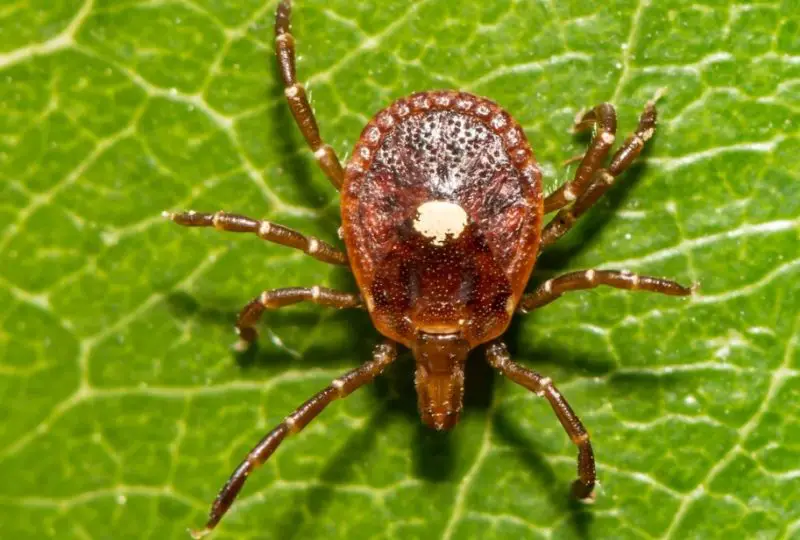
The Lone Star Tick is a medium-sized tick species easily identified by the distinct white or silvery spot on the back of adult females, resembling a “lone star.” Males, while lacking this marking, have ornate patterns along the edge of their brownish-red bodies. Adults measure about 3–4 millimeters when unfed but swell significantly after feeding. This tick is notorious for its aggressive feeding behavior and strong attachment to hosts, including humans, pets, and wildlife.
Lone Star Ticks are found primarily in the southeastern and eastern United States, thriving in wooded areas, tall grasses, and dense underbrush. They are highly active during the warmer months and are known to pursue hosts by sensing carbon dioxide, body heat, and movement. Their life cycle includes larval, nymph, and adult stages, with each requiring a blood meal to progress. White-tailed deer are their main hosts, but they readily feed on other mammals and humans.
These ticks pose a serious health risk as they transmit diseases such as ehrlichiosis, tularemia, and Southern Tick-Associated Rash Illness (STARI). More uniquely, their bites have been linked to “alpha-gal syndrome,” a red meat allergy caused by an immune reaction to a sugar molecule introduced through their saliva. Symptoms of bites include itching, redness, swelling, and in some cases, severe allergic reactions. Preventive measures include using tick repellents, wearing protective clothing, and checking for ticks after outdoor activities.
American Dog Tick (Dermacentor variabilis)
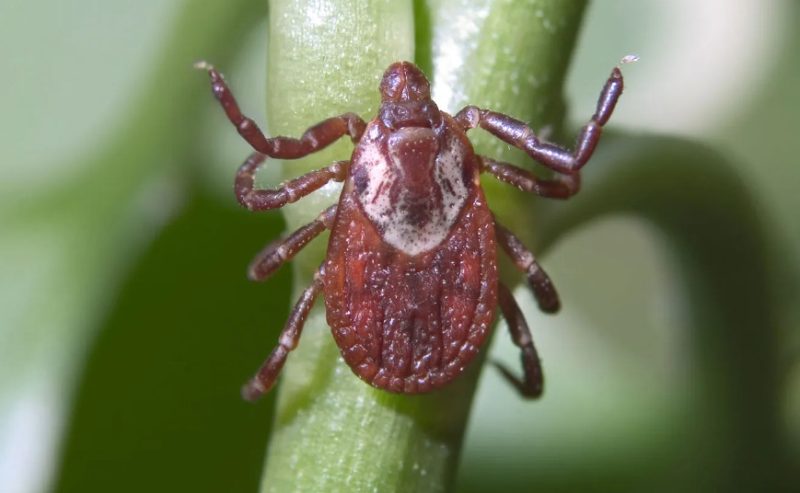
The American Dog Tick is one of the most common ticks in North America, recognized by its reddish-brown body with distinctive gray or white markings on its back. Adults are larger than many other tick species, with females measuring up to 5 millimeters unfed and significantly enlarging after feeding. Their robust body and patterned scutum (shield) make them easily distinguishable from other ticks.
These ticks inhabit grassy fields, trails, and areas frequented by pets and wildlife, particularly dogs, which serve as their preferred hosts. They are most active in spring and early summer, waiting on vegetation to attach to passing hosts. Both larvae and nymphs feed on small mammals, while adults target larger animals. American Dog Ticks are hardy and can survive for extended periods without feeding, making them a persistent presence in their habitats.
The species is a known vector of Rocky Mountain spotted fever and tularemia, both serious illnesses in humans. Their bites can also cause tick paralysis, a condition resulting from neurotoxins in their saliva that affect motor function. Although not every tick carries disease, removal should be done promptly using fine-tipped tweezers, followed by disinfection of the bite area. Regular tick checks on pets and humans are crucial for early detection and prevention of tick-borne infections.
Kissing Bug (Triatoma sanguisuga)

The Kissing Bug, or Triatomine Bug, is a nocturnal blood-feeding insect recognized by its elongated, cone-shaped head, dark brown or black body, and orange or red markings along the abdomen’s edges. Adults measure around 1 inch (25 mm) long with narrow wings and a piercing-sucking mouthpart used to feed on blood. They earned their nickname by their tendency to bite near the lips or eyes of sleeping humans.
Kissing Bugs are typically found in the southern United States, particularly in rural or wooded regions. They often inhabit cracks in walls, animal shelters, or rodent nests, emerging at night to feed on mammals. After feeding, they defecate near the bite wound, which can lead to infection if feces containing the Trypanosoma cruzi parasite are rubbed into the skin or eyes. This parasite causes Chagas disease, a potentially serious illness.
A Kissing Bug bite may cause redness, swelling, and itching, but the real danger comes from disease transmission. Chagas disease can lead to chronic heart and digestive system damage if untreated. Preventive actions include sealing cracks in homes, using bed nets in infested areas, and avoiding sleeping near open windows without screens. Because these insects can resemble harmless species, expert identification is recommended when found indoors.
Assassin Bug (Reduviidae family)
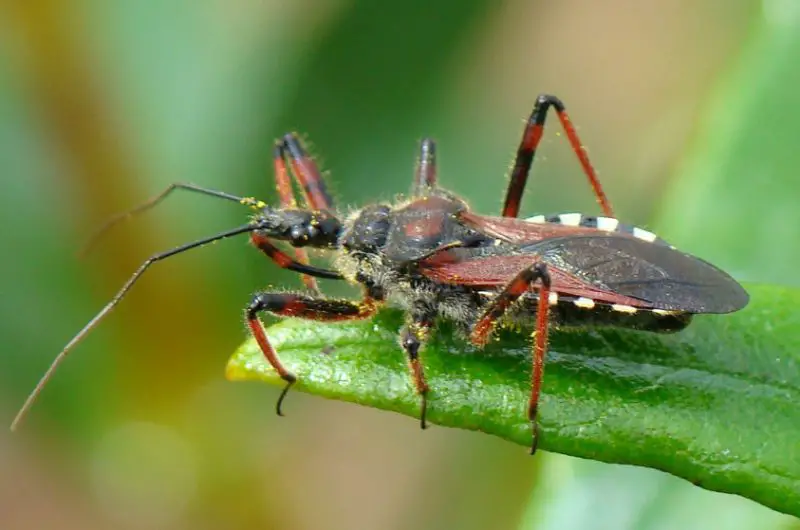
Assassin Bugs are a diverse group of predatory insects belonging to the Reduviidae family, known for their elongated heads, curved beaks, and strong raptorial legs. Most species range from 0.5 to 1 inch in length and exhibit colors from brown to black, sometimes with red or orange markings. Their defining feature is the sharp, needle-like rostrum used to pierce and inject enzymes into prey, liquefying their insides for consumption.
These insects are beneficial predators, feeding on pests like caterpillars, flies, and beetles. Assassin Bugs inhabit gardens, forests, and grasslands, often hiding under leaves or bark while waiting to ambush prey. They use stealth and speed to strike, delivering quick and deadly attacks. While their hunting role benefits agriculture, their bite can be painful to humans if handled or provoked.
The bite of an Assassin Bug is intensely painful and may cause swelling, redness, and numbness at the site. Although not venomous or medically dangerous in most cases, some members of the family, such as Kissing Bugs, can transmit diseases. People should avoid touching them with bare hands and instead relocate them carefully if found indoors. Their presence in gardens, however, should generally be welcomed for their natural pest control abilities.
Wheel Bug (Arilus cristatus)
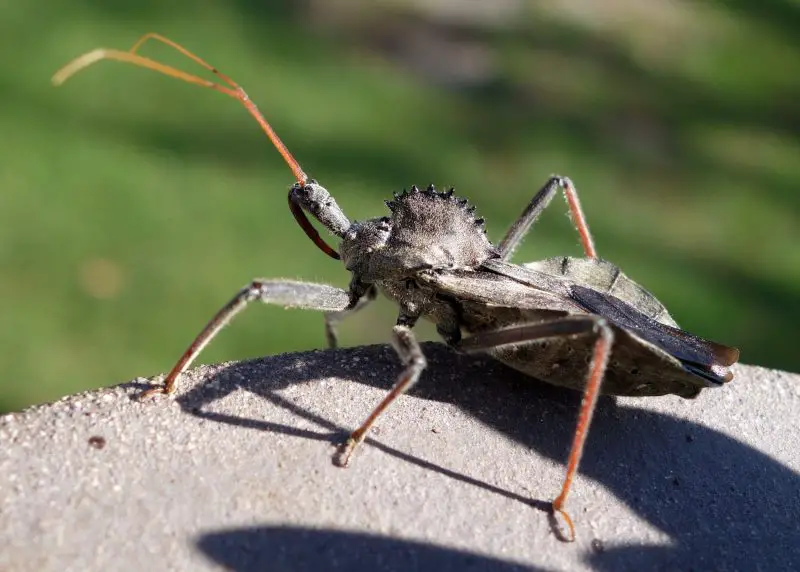
The Wheel Bug, a member of the Assassin Bug family, is one of the largest and most striking predatory insects in North America. Adults measure up to 1.5 inches (38 mm) long and are grayish-brown with a prominent semicircular crest on their thorax resembling a cogwheel—hence their name. They have long legs, a narrow head, and a sharp beak used for piercing prey. Despite their intimidating appearance, they are beneficial predators.
Wheel Bugs are found in wooded areas, gardens, and fields, where they prey on caterpillars, beetles, and other soft-bodied insects. They are slow-moving and deliberate hunters that use stealth to approach and stab their prey with a venomous saliva that paralyzes and digests internal tissues. Their presence indicates a healthy ecosystem, as they help control pest populations naturally without the need for pesticides.
Although they are not aggressive toward humans, their bite can cause severe pain, swelling, and localized numbness that may last for days. The wound may blister and heal slowly but is not typically dangerous. It’s best to admire these insects from a distance and avoid handling them. Despite their painful defense mechanism, Wheel Bugs are valuable allies in agriculture and home gardens due to their role as natural pest predators.
Blister Beetle (Meloidae family)
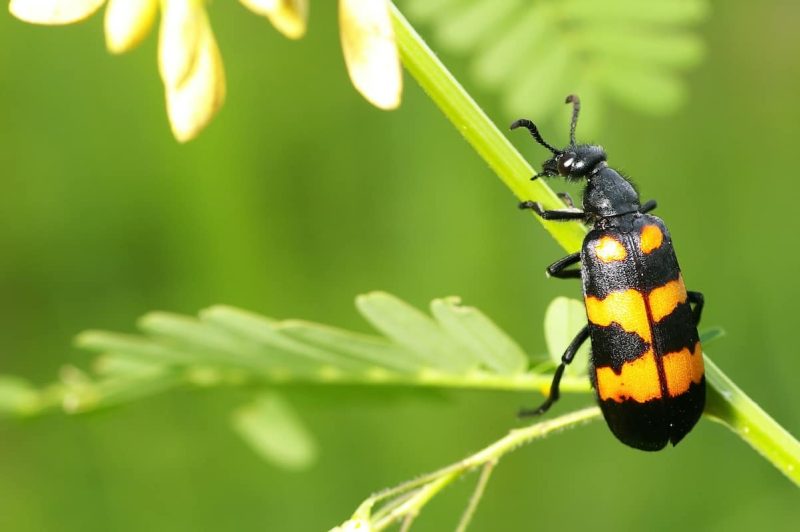
Blister Beetles are elongated, soft-bodied insects that range in color from metallic green and blue to dull gray or black. They vary in size from 0.5 to 1 inch (12–25 mm) long and are easily recognized by their flexible wing covers and narrow thorax. Despite their fragile appearance, they possess one of the most potent natural chemical defenses known as cantharidin, a blistering agent capable of irritating human skin.
These beetles are commonly found in fields, gardens, and meadows where they feed on flowers, leaves, and crops such as alfalfa, potatoes, and soybeans. Adult Blister Beetles are active during warm weather and often gather in large numbers, while their larvae are parasitic, preying on grasshopper eggs or bee larvae. They play a mixed ecological role — both beneficial as natural pest control and harmful as crop pests.
Direct contact with Blister Beetles can cause painful blisters, redness, and irritation on human skin. Ingestion of crushed beetles, even accidentally in contaminated hay, can be lethal to livestock due to cantharidin poisoning. Humans should avoid handling these insects with bare hands. Protective gloves and awareness are key when working in infested fields or collecting plants where Blister Beetles are active.
Velvet Ant “Cow Killer” (Dasymutilla occidentalis)
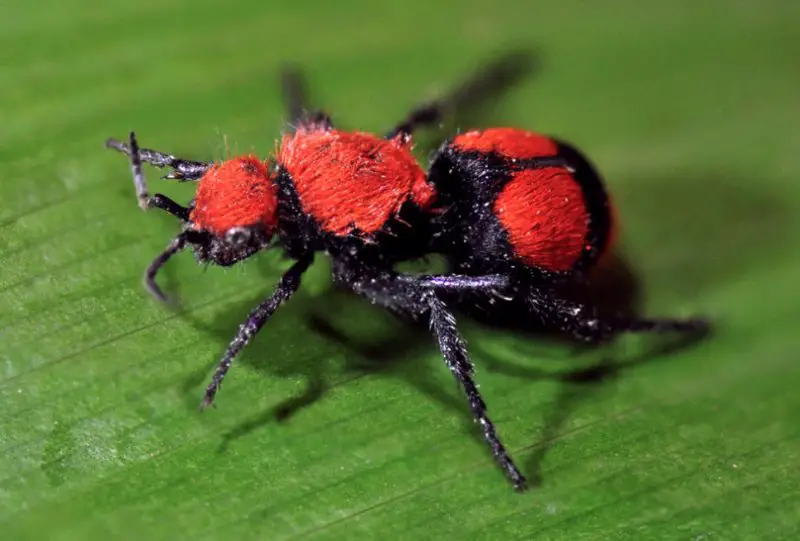
The Velvet Ant, commonly called the “Cow Killer,” is actually a wingless female wasp covered in dense, velvety red-orange and black hairs. Males, which have wings, share similar coloration but cannot sting. Adults measure around 0.75 inches (19 mm) long and move with a rapid, erratic gait. Their bright warning coloration and tough exoskeleton serve as effective deterrents to predators.
Velvet Ants inhabit dry, sandy areas, open meadows, and pastures, where females search for ground-nesting bee and wasp burrows. They lay eggs inside host larvae chambers, where their offspring develop by feeding on the host pupae. Despite their solitary nature, Velvet Ants are often spotted wandering during hot summer months. They are generally non-aggressive but will sting if handled or trapped.
The sting of a female Velvet Ant is excruciatingly painful, earning it the nickname “Cow Killer.” Though not lethal to humans, the venom causes intense burning and swelling that can last for hours. Their thick cuticle makes them difficult to crush, and their loud squeaking sound when disturbed is a defensive warning. Avoid handling them and use caution when walking barefoot in sandy or grassy areas where they roam.
Giant Water Bug (Lethocerus americanus)
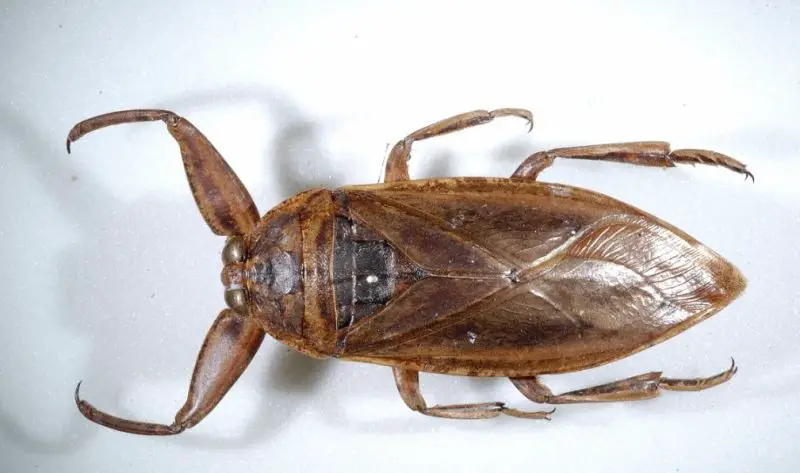
The Giant Water Bug is one of the largest aquatic insects in North America, measuring up to 2.5 inches (65 mm) long. It has a flattened, oval body, large front legs adapted for grasping prey, and a short beak for piercing and sucking. Its brownish coloration provides camouflage in muddy or vegetated water environments. Despite its size, it is an adept swimmer and powerful predator.
These bugs inhabit ponds, lakes, and slow-moving streams, often hiding under debris or aquatic plants. They are ambush predators that feed on fish, tadpoles, frogs, and insects. Giant Water Bugs deliver a paralyzing enzyme through their beak, liquefying the internal tissues of prey before consumption. Adults can fly and are sometimes attracted to lights at night, leading people to find them on porches or near street lamps.
Their bite, though not venomous, is considered one of the most painful among insects. It causes intense burning, swelling, and temporary numbness but rarely leads to serious complications. Because they are beneficial in controlling mosquito larvae and aquatic pests, they should not be killed unnecessarily. Handling should always be avoided, as their defensive strikes are swift and forceful.
Horsefly (Tabanus spp.)

Horseflies are large, robust flies with green or gold compound eyes and gray or black bodies. Females measure 0.75 to 1 inch (20–25 mm) in length and have blade-like mouthparts designed for cutting skin and feeding on blood. Males, which feed only on nectar, have contiguous eyes and pose no biting threat. These flies are powerful fliers and are most active in warm, humid conditions.
Horseflies are typically found near wetlands, pastures, and wooded areas where livestock and wildlife gather. Females require blood meals for egg development and often target horses, cattle, and humans. Their bites are painful because they cut rather than pierce the skin, causing bleeding and irritation. They are also vectors for diseases such as tularemia and equine infectious anemia in animals.
The bite of a Horsefly results in sharp pain, swelling, and itching. Secondary infections may occur if the wound is scratched or not cleaned properly. Using insect repellents, wearing light-colored clothing, and avoiding outdoor activities near water during peak hours can help prevent bites. Although not deadly, Horseflies can make outdoor experiences miserable due to their persistence and painful attacks.
Deer Fly (Chrysops spp.)

Deer Flies are smaller relatives of Horseflies, measuring about 0.25 to 0.5 inches (6–13 mm) long. They are easily recognized by their patterned wings, brightly colored eyes, and gray or yellow bodies. Females feed on blood, while males subsist on nectar and pollen. Their bite is sharp and painful due to scissor-like mouthparts that tear the skin.
These flies are found in marshes, forests, and areas near streams or ponds, particularly in summer. Deer Flies are most active during daylight and are drawn to movement, heat, and carbon dioxide. They commonly bite humans on the head, neck, and shoulders. Their larvae develop in moist soil or decaying vegetation, where they feed on organic material.
Deer Fly bites cause painful welts, swelling, and itching that can last several days. In rare cases, they can transmit diseases such as tularemia and Lyme-like illnesses. Wearing hats, applying DEET-based repellents, and using physical barriers like mesh nets are effective prevention methods. Because of their stealth and speed, Deer Flies are among the most irritating outdoor biting insects.
Chigger (Trombiculidae family)
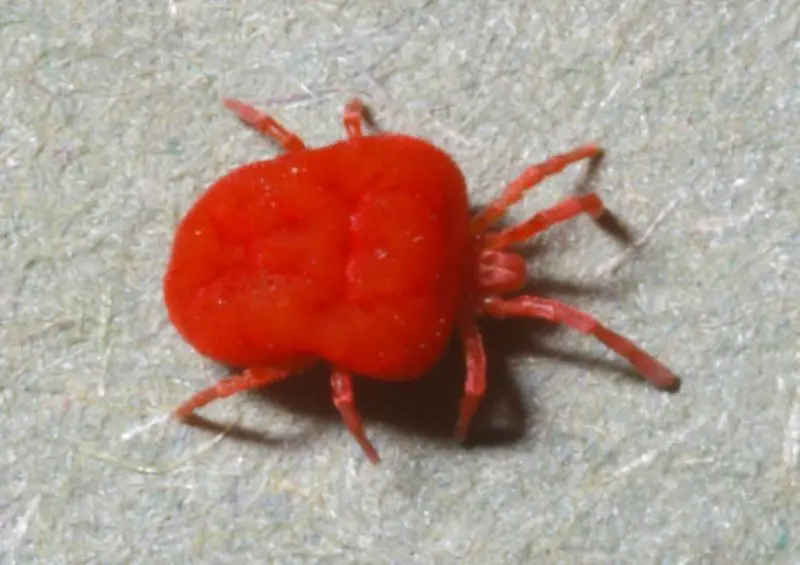
Chiggers are the larval stage of tiny red mites, barely visible to the naked eye at less than 0.3 millimeters in size. Despite their minuscule appearance, they cause intense itching and irritation through their feeding habits. They are bright red or orange and cluster in grassy or wooded areas, particularly in warm, humid climates.
Chiggers do not burrow into the skin, contrary to popular belief. Instead, they attach to pores or hair follicles and inject digestive enzymes that break down skin cells, feeding on the liquefied tissue. Their bites commonly occur around the ankles, waistline, and areas where clothing fits tightly. The resulting welts are intensely itchy and may last up to two weeks if not treated.
While Chiggers do not transmit diseases in the U.S., their bites can lead to secondary infections from scratching. Applying calamine lotion or hydrocortisone cream helps relieve discomfort. To prevent bites, wear long sleeves, apply insect repellent containing DEET or permethrin, and avoid sitting directly on grass. Taking a hot shower after outdoor activities can help remove any lingering mites before they attach.
Scorpion (Centruroides vittatus – Striped Bark Scorpion)
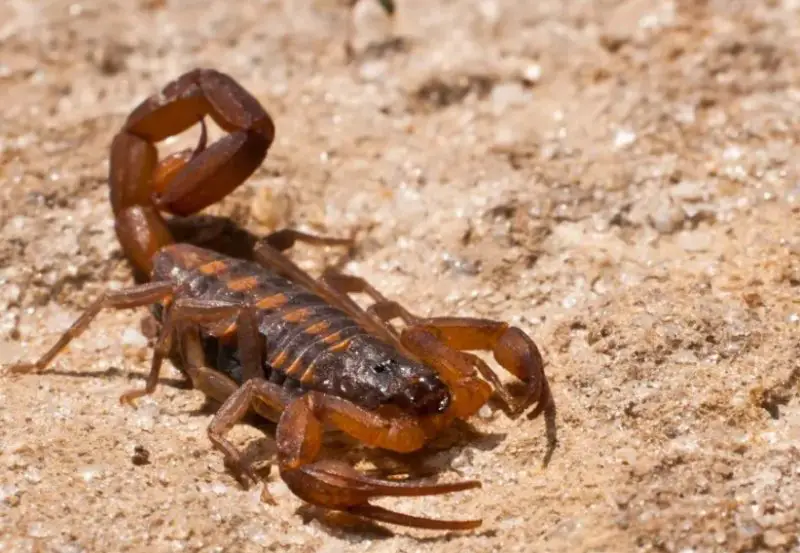
The Striped Bark Scorpion is the most widespread scorpion species in the United States, typically measuring 2 to 3 inches (50–75 mm) long. It has a pale yellow body with two dark stripes running down its back and a segmented tail ending in a venomous stinger. Its pincers are relatively slender, which distinguishes it from bulkier, non-venomous species.
This scorpion thrives in warm, arid environments and often seeks shelter under rocks, logs, or debris. It’s nocturnal, emerging at night to hunt insects and spiders. Striped Bark Scorpions are also known for their climbing ability, often entering homes through walls, ceilings, and windows. They are most active during summer months and prefer humid microclimates in otherwise dry regions.
The sting of a Striped Bark Scorpion is painful and produces a burning sensation, numbness, and localized swelling. While not typically fatal, children and allergic individuals may experience more severe symptoms, such as difficulty breathing or muscle twitching. Medical attention is recommended for severe reactions. Keeping living spaces dry, sealing entry points, and shaking out clothing or shoes before use can help prevent stings.
Stink Bug (Halyomorpha halys)
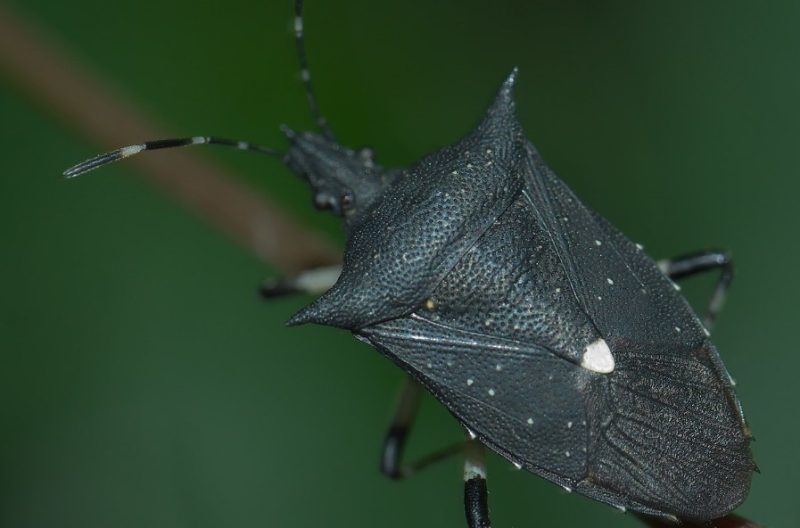
The Stink Bug, or Brown Marmorated Stink Bug, is a shield-shaped insect about 0.5 to 0.75 inches (12–19 mm) long with mottled brown and gray coloring. It has six legs, long antennae, and a distinctive triangular plate on its back. When threatened or crushed, it releases a foul-smelling odor produced by glands on its abdomen — a defense mechanism that deters predators.
Stink Bugs are native to East Asia but have become invasive across the United States. They feed on fruits, vegetables, and ornamental plants, piercing them with their needle-like mouthparts to suck out sap. This feeding can cause deformities and discoloration in crops such as apples, peaches, and tomatoes, resulting in significant agricultural damage. During colder months, they often invade homes seeking warmth.
Although Stink Bugs do not bite, sting, or transmit disease, they are considered nuisance pests due to their odor and persistence. Crushing them should be avoided, as it releases the unpleasant scent. Instead, they can be removed with a vacuum or caught using traps. Sealing cracks around doors and windows helps prevent infestations during the fall migration season.
Tips for Avoiding Dangerous Bugs in Louisiana
Louisiana’s warm, humid climate makes it a haven for insects, many of which can bite, sting, or transmit disease. Taking a few precautions can help you enjoy the outdoors safely while avoiding potentially harmful encounters.
One of the best tips for avoiding dangerous bugs in Louisiana is to wear protective clothing when exploring wooded areas, swamps, or tall grass. Long sleeves, pants tucked into socks, and light-colored fabrics can reduce exposure to ticks and mosquitoes. Applying an EPA-approved insect repellent containing DEET or picaridin is also an effective defense, especially during early morning and evening hours when mosquitoes are most active.
Keeping your surroundings clean and well-maintained can also minimize encounters. Remove standing water near your home to prevent mosquito breeding, and seal cracks or gaps around windows, doors, and foundations to block spiders, wasps, or ants from entering. When gardening or handling firewood, wear gloves to avoid hidden spiders or scorpions. Finally, if you’re allergic to insect stings, carry an epinephrine auto-injector (EpiPen) and seek immediate medical help after any severe reaction.
FAQs About Dangerous Bugs in Louisiana
What is the most dangerous bug in Louisiana?
The Brown Recluse Spider is often considered the most dangerous bug in Louisiana because its venom can cause serious skin necrosis and systemic symptoms. The Black Widow Spider is also highly venomous and requires prompt medical attention if bitten.
Do mosquitoes in Louisiana carry diseases?
Yes, mosquitoes in Louisiana can carry several diseases, including West Nile virus, Zika virus, and Eastern Equine Encephalitis (EEE). Using insect repellent and eliminating standing water sources are key preventive measures.
Are fire ants a big problem in Louisiana?
Absolutely. Red Imported Fire Ants are widespread throughout Louisiana and are known for their aggressive behavior and painful stings. Their venom can cause burning sensations, blisters, and, in some cases, severe allergic reactions.
Can ticks in Louisiana transmit Lyme disease?
While Lyme disease is less common in Louisiana than in northern states, ticks such as the Lone Star Tick can spread other illnesses like Ehrlichiosis and Southern Tick-Associated Rash Illness (STARI). Always check your body and pets for ticks after outdoor activities.
How can I safely remove a tick if bitten?
Use fine-tipped tweezers to grasp the tick as close to your skin as possible, then pull upward with steady, even pressure. Clean the area with antiseptic and monitor for signs of infection or rash. Avoid twisting or crushing the tick, as this can increase infection risk.
What should I do if stung by a wasp or hornet?
Clean the sting site with soap and water, then apply a cold compress to reduce swelling. Over-the-counter antihistamines or hydrocortisone cream can help relieve itching. If you experience trouble breathing, dizziness, or swelling of the face or throat, seek emergency medical care immediately.
Do scorpions live in Louisiana?
Yes, the Striped Bark Scorpion (Centruroides vittatus) is found in Louisiana, especially in dry, wooded, or rocky areas. Its sting can be painful but is rarely fatal; still, medical attention is recommended for young children or those with severe reactions.
How can I protect my home from spiders and insects?
Regularly vacuum, declutter, and seal entry points around your home. Store firewood away from the house, keep outdoor lights dim (to avoid attracting insects), and use natural deterrents like peppermint oil sprays in corners and basements.






